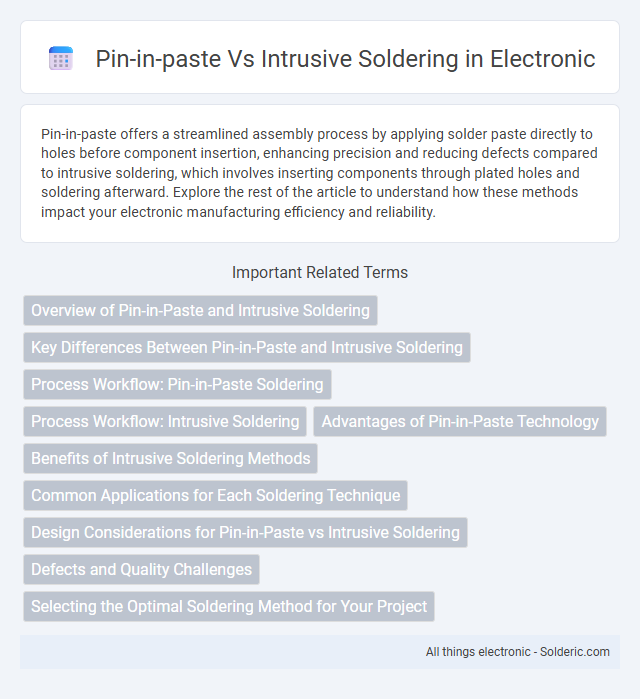Pin-in-paste offers a streamlined assembly process by applying solder paste directly to holes before component insertion, enhancing precision and reducing defects compared to intrusive soldering, which involves inserting components through plated holes and soldering afterward. Explore the rest of the article to understand how these methods impact your electronic manufacturing efficiency and reliability.
Comparison Table
| Feature | Pin-in-Paste | Intrusive Soldering |
|---|---|---|
| Process Type | Solder paste application with through-hole components | Direct soldering using a soldering iron or wave soldering |
| Assembly Speed | Faster due to paste reflow process | Slower manual or semi-automated process |
| Solder Quality | Consistent, controlled solder joints | Variable quality, dependent on operator skill |
| Applicability | Suitable for high-volume manufacturing | Better for prototyping and repair |
| Equipment Required | Stencil printer and reflow oven | Soldering iron, wave soldering machine |
| Cost Efficiency | Cost-effective for mass production | Higher labor costs, less efficient |
| Reliability | High reliability with uniform solder joints | Potential inconsistencies in solder joints |
Overview of Pin-in-Paste and Intrusive Soldering
Pin-in-Paste (PiP) is a surface-mount technology that enhances traditional through-hole soldering by dispensing solder paste onto PCB pads before component insertion, optimizing reflow processes for mixed-technology assemblies. Intrusive soldering involves inserting component leads through pre-tinned or plated holes, relying on capillary action during solder wave or manual soldering to secure connections, primarily used in through-hole technology. PiP offers improved automation and joint quality with reduced thermal stress compared to the manual and wave soldering methods of intrusive soldering.
Key Differences Between Pin-in-Paste and Intrusive Soldering
Pin-in-paste soldering involves applying solder paste onto PCB pads before inserting through-hole components, enabling simultaneous reflow of both surface-mount and through-hole parts, whereas intrusive soldering requires separate wave soldering or hand soldering processes after component placement. Pin-in-paste offers precise solder volume control and reduced component movement, leading to enhanced joint reliability compared to intrusive soldering's risk of solder bridging and component shifting. Production efficiency improves with pin-in-paste by consolidating soldering stages, while intrusive soldering demands additional equipment and increased labor time.
Process Workflow: Pin-in-Paste Soldering
Pin-in-paste soldering streamlines the process by applying solder paste directly onto printed circuit board (PCB) pads before inserting through-hole component pins, combining reflow soldering with traditional assembly techniques. This method eliminates the need for wave soldering, as the solder paste melts during reflow, securely bonding the pins to the PCB while reducing thermal stress and solder bridging. The efficient workflow enhances precision and supports high-mix, low-volume production environments with improved solder joint quality and process reliability.
Process Workflow: Intrusive Soldering
Intrusive soldering involves inserting component leads directly into pre-drilled PCB holes, followed by applying solder to secure and electrically connect the parts. This process requires precise alignment of pins and controlled solder flow to ensure reliable mechanical and electrical bonding without damaging the board. Automated wave soldering or selective soldering machines often facilitate consistent solder application during the workflow.
Advantages of Pin-in-Paste Technology
Pin-in-Paste technology offers precise solder paste application directly onto PCB pads, enhancing solder joint reliability and minimizing solder bridging compared to intrusive soldering. This method significantly reduces assembly time and labor costs by enabling simultaneous component placement and soldering processes. Your production benefits from improved thermal performance and consistent quality due to reduced solder volume variability inherent in traditional intrusive soldering techniques.
Benefits of Intrusive Soldering Methods
Intrusive soldering methods offer enhanced mechanical stability by ensuring solder joints penetrate deeply into component leads and PCB pads, significantly improving electrical conductivity and durability. This technique reduces the risk of cold solder joints and increases resistance to thermal and mechanical stress, making it ideal for high-reliability electronics manufacturing. Intrusive soldering also facilitates faster heat dissipation, which helps maintain component integrity during the soldering process.
Common Applications for Each Soldering Technique
Pin-in-paste soldering is commonly used in surface-mount technology (SMT) for assembling printed circuit boards (PCBs) with densely packed components, especially in consumer electronics and automotive applications. Intrusive soldering is preferred for through-hole components requiring strong mechanical bonds, often found in aerospace, industrial machinery, and high-reliability electronic devices. Each technique optimizes assembly processes based on component type, mechanical stress tolerance, and production volume.
Design Considerations for Pin-in-Paste vs Intrusive Soldering
Design considerations for Pin-in-Paste versus intrusive soldering emphasize solder joint reliability and manufacturing efficiency. Pin-in-Paste requires precise stencil printing to deposit solder paste on through-hole pads before component insertion, enhancing thermal heat dissipation and reducing wave soldering steps. Intrusive soldering involves solder flowing inside the plated through-holes, necessitating careful pad and hole sizing to ensure consistent solder fillet formation and avoid voids or insufficient wettability.
Defects and Quality Challenges
Pin-in-paste soldering often faces challenges such as solder bridging, insufficient solder joints, and tombstoning due to paste misapplication or component movement during reflow. Intrusive soldering can exhibit defects like solder voids, skewed components, and thermal damage from excessive heat exposure. Both methods require precise process control to minimize defects and ensure high-quality, reliable assemblies in electronic manufacturing.
Selecting the Optimal Soldering Method for Your Project
Selecting the optimal soldering method for your project depends on factors such as component density, mechanical stability, and thermal requirements. Pin-in-paste soldering offers precise solder paste application for through-hole components, enhancing joint reliability and reducing assembly time. Intrusive soldering provides robust mechanical bonds ideal for high-vibration environments but may require more complex setup and thorough flux management.
Pin-in-paste vs intrusive soldering Infographic

 solderic.com
solderic.com